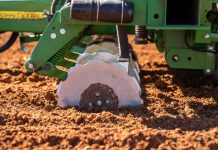
on behalf of SANSOR
Honey bees have been playing a crucial role in food production for thousands of years. Humans have kept bees to harvest honey, but also to assist with crop pollination. Across the world, millions of hectares of fruit, vegetables, oilseeds and legume crops depend on insect pollination.
Many commercial food crops in South Africa are dependent on bees for pollination. Without the pollination service that insects, and especially honey bees provide, it would be difficult for producers to produce many crops and realise a profitable yield. Some crops may even fail altogether.
These include:
- vegetables such as beetroot, celery, onions, broccoli, cauliflower, cabbage, brussels sprouts, peppers, cucumbers and carrots;
- grains such as sunflower, canola, rapeseed and alfalfa;
- forage crops such as clover;
- beans and sprouts; as well as
- herbs such as mustard, caraway, coriander, cardamom and fennel.
Bees are as important as water for food production and seed companies and producers should collectively invest in not only protecting our bee population, but also in facilitating healthy colonies.
Bees as pollinators make out 80% of the insect population on vegetable seed crops, says Nico Mienie, logistics manager at Klein Karoo Seed Production. The other 20% of pollinating insects consist of spiders, flees, butterflies, moths, etc. The biggest challenge during pollination of seed crops, is to ensure that the seed plantings are acceptable to the bees during pollination.
 Although many crops are dependent on pollinators, the same crops are also threatened by weeds, insect pests and disease. Pesticides are one of the solutions in the producer’s tool box to protect crops. But according to Dr Lukeshni Chetty, general manager at the South African National Seed Organisation (SANSOR), crop protection must go hand in hand with the protection of pollinators.
Although many crops are dependent on pollinators, the same crops are also threatened by weeds, insect pests and disease. Pesticides are one of the solutions in the producer’s tool box to protect crops. But according to Dr Lukeshni Chetty, general manager at the South African National Seed Organisation (SANSOR), crop protection must go hand in hand with the protection of pollinators.
With the majority of food crops being pollinated by bees, dwindling colonies pose a real threat to agriculture. ‘While pesticides are often cited as one of the major reasons for declining bee numbers, there are actually multiple contributing factors. Monoculture crops and a lack of biodiversity are actually a greater problem,’ Dr Chetty says.
Reasons for the decline of bee numbers include the following:
- Insufficient forage areas lead to insufficient honey and pollen reserves to carry bees through winter or a period of forage shortage. Bees require a diverse diet. Moving a colony from one sunflower field to the other repeatedly and thus only providing one food source for weeks on end, is not conducive to good bee health. Healthy swarms need a varied diet to produce healthy offspring.
- Pesticides including seed treatments – especially systemic chemicals. Bees are susceptible to many broad-spectrum insecticides and the indiscriminate use of these chemicals can be detrimental to bee colonies.
- Parasites.
- Disease.
- The loss and destruction of habitat.
Most pollinator poisoning occurs when pesticides are applied indiscriminately to flowering crops, pastures and weeds. Dr Chetty advises that the following guidelines should be followed when controlling pest insects:
- Scout to determine the economical threshold of the insect damage before spraying. The idea is not to eliminate all pest insects. Successful pest management is about finding the best solution to combat or deter those insects that can destroy crops, while at the same time supporting beneficial insects like bees and other pollinators.
- Take great care when, where, and how to apply insecticides.
- Implement biological control methods as part of an integrated pest management system.
- Before making an application, be aware of any pollinators such as honeybees and hives nearby.
- Communicate with neighbouring producers and beekeepers.
- To reduce bee losses, producers must adhere to the recommendations on the crop protection product labels. Most problems occur when people apply products outside the registration recommendations.
- During the flowering phase of crops and trees, select the least harmful insecticide to bees and other beneficial insects and spray in the late afternoon or at night.
- Do not spray in windy conditions when the spray may drift onto adjacent lands supporting foraging bees or other pollinators.
- Avoid using dust products.
- Do not use herbicides on flowering weeds near orchards or fields. Weeds should be controlled before flowering or by mechanical methods such as slashing.
- Pesticide use should be kept to a minimum while there are hives on a property or when hives are installed permanently. Avoid using pesticides near the hives altogether.
- Educate field workers or applicators to ensure they make informed decisions regarding pesticide applications and that they follow the product labels.
- Always consider biodiversity and environmental safety.
Intensive farming practices led to the destruction of large suitable forage areas for bees. This also led to the reduction in the diversity and quantity of nectar available for bees, leading to poor nutrition for bee colonies.
Field netting and greenhouses
To pollinate vegetables produced in greenhouses, honey bees will need to be kept in the greenhouse. The greenhouse must, however, provide the right conditions for the bees to thrive. Honeybees are extremely sensitive to temperature changes. When using bees for pollination in greenhouses, great care must be taken to keep the temperature as even as possible and not above 45˚C.
The use of netting to protect crops from hail, wind and birds is becoming increasingly popular among vegetable and fruit growers. However, if not done correctly, it can seriously affect pollination. Producers should be able to lift the ends or sides of netting during flowering to aid pollination.
‘It is key to talk to beekeepers before the netting is installed. Some types of netting will result in no bees being able to reach the crops or bees becoming entangled. Netting can also increase humidity and therefore the need to use fungicides to manage diseases. Producers are advised to take all these factors into consideration,’ says Dr Chetty.
What can be done?
Without nature’s pollination services many crops may fail and the agricultural sector would struggle.
According to Dr Chetty there are certain principles that producers should consider when protecting their crops. ‘An integrated pest management strategy that focusses on long-term prevention of pests and their damage through a combination of techniques such as chemical, cultural and biological control, as well as targeted habitat management, like increased plant diversity, should be implemented.’
She adds that producers can support pollinator health by implementing sustainable, pollinator-friendly practices on-farm such as the planting of cover crops like clover, vetch and lucerne. Producers can also consider planting wildflower strips, providing hives with an additional feed source. Plants that can sustain honey bee colonies include African blue basil, lavender, bottlebrush, aloes, and flowering blackjacks. Bee forage areas can be planted on rocky outcrops, around and between crop fields and on road verges.
Product stewardship is essential and requires collaboration, engagement and support by all stakeholders. With proper stewardship, the broader industry can assure that best practices are being consistently implemented with the safety of users, consumers and the environment in mind. This will include managing any risks to pollinators.
The following practices are recommended:
- Use conservation agricultural practices.
- Make use of an integrated pest management system.
- Use pesticides, herbicides, and insecticides responsibly on and off the farm.
- Use softer crop protection chemicals – specifically bee-friendly products.
- Make use of biological control methods.
- Create a habitat that sustains and enhances pollinator colonies on the farm.
- Plant appropriate vegetation that can act as refuge areas for the pollinators.
- Do not clean planter equipment/hoppers near fields, especially around flowering plants.




























